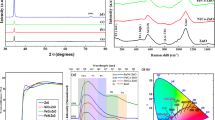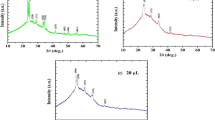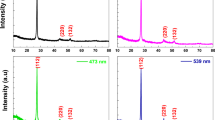Abstract
In this report, Ag nanoparticles were fabricated using the single-step glancing angle deposition (SS-GLAD) technique upon In2O3/TiO2 thin film. Afterward, a detailed analysis was done for the two samples such as In2O3/TiO2 thin film and In2O3/TiO2 thin film/Ag nanoparticles, to inspect the field emission scanning electron microscopy (FESEM), energy-dispersive X-ray analysis (EDAX), X-ray diffraction (XRD), ultraviolet (UV) spectroscopy, and electrical properties. The reduction in bandgap energy for the samples of In2O3/TiO2 thin film/Ag nanoparticles (~4.16 eV) in comparison with the In2O3/TiO2 thin film (~4.28 eV) was due to trapped e–h recombination at the oxygen vacancies and electron transmission of Ag to the conduction band of the In2O3/TiO2 thin films. Moreover, under irradiation of photons Ag nanoparticles generated inorganic Ag–O compound attributable to the localized surface plasmon resonance (LSPR). Also, a ~90% high transmittance, ~60% and ~25% low reflectance in UV and visible region, fill factor (FF) of 53%, as well as power conversion efficiency (PCE) of 15.12% was observed for In2O3/TiO2 thin film/Ag nanoparticles than the In2O3/TiO2 thin film. Therefore, the use of Ag nanoparticles textured In2O3/TiO2 thin film–based device is a promising approach for the forthcoming photovoltaic applications.





Similar content being viewed by others
Data Availability
The materials described in the manuscript, including all relevant raw data, will be freely available from the corresponding author upon reasonable request.
References
Bertoluzzi L, Ma S (2012) On the methods of calculation of the charge collection efficiency of dye sensitized solar cells. Phys Chem Chem Phys 15(12):4283–4285. https://doi.org/10.1039/c3cp44248a
Gratzel M (2005) Solar energy conversion by dye-sensitized photovoltaic cells. Inorg Chem 44(20):6841–6851. https://doi.org/10.1021/ic0508371
Katoh R, Furube A (2014) Electron injection efficiency in dye-sensitized solar cells. J Photochem Photobiol C 20:1–16. https://doi.org/10.1016/j.jphotochemrev.2014.02.001
Liu M, Johnston MB, Snaith HJ (2013) Efficient planar heterojunction perovskite solar cells by vapour deposition. Nature 501(7467):395–398. https://doi.org/10.1038/nature12509
Park NG (2015) Perovskite solar cells: an emerging photovoltaic technology. Mater Today 18(2):65–72. https://doi.org/10.1016/j.mattod.2014.07.007
Wu R, Yang Y, Li M, Qin D, Zhang Y, Hou L (2017) Solvent engineering for high-performance PbS quantum dots solar cells. Nanomaterials 7(8):201(1–13). https://doi.org/10.3390/nano7080201
Wang Z, Hu Z, Kamarudin MA, Kapil G, Tripathi A, Shen Q, Yoshino K, Minemoto T, Pandey SS, Hayase S (2018) Enhancement of charge transport in quantum dots solar cells by N-butylamine-assisted sulfur-crosslinking of PbS quantum dots. Sol Energy 174:399–408. https://doi.org/10.1016/j.solener.2018.09.026
Yu P, Zhu K, Norman AG, Ferrere S, Frank AJ, Nozik AJ (2006) Nanocrystalline TiO2 Solar Cells Sensitized with InAs Quantum Dots. J Phys Chem B 110(50):25451–25454. https://doi.org/10.1021/jp064817b
Shrotriya V, Li G, Yao Y, Moriarty T, Emery K, Yang Y (2006) accurate measurement and characterization of organic solar cells. Adv Funct Mater 16(15):2016–2023. https://doi.org/10.1002/adfm.200600489
Morel DL, Ghosh AK, Feng T, Stogryn EL, Purwin PE (1978) High efficiency organic solar cells. Appl Phys Lett 32(8):495–497. https://doi.org/10.1063/1.90099
Stuart HR, Hall DG (1996) Absorption enhancement in silicon on insulator waveguides using metal island films. Appl Phys Lett 69(16):2327–2339. https://doi.org/10.1063/1.117513
Deng Y, Cao G, Yang H, Zhou X, Wu Y (2018) Dynamic control of double plasmon-induced transparencies in aperture-coupled waveguide-cavity system. Plasmonics 13(1):345–352. https://doi.org/10.1007/s11468-017-0519-z
Deng Y, Cao G, Wu Y, Zhou X, Liao W (2015) Theoretical description of dynamic transmission characteristics in MDM waveguide aperture-side-coupled with ring cavity. Plasmonics 10(6):1537–1543. https://doi.org/10.1007/s11468-015-9971-9
Cao G, Li H, Deng Y, Zhan S, He Z, Li B (2014) Systematic theoretical analysis of selective-mode plasmonic filter based on aperture-side-coupled slot cavity. Plasmonics 9(5):1163–1169. https://doi.org/10.1007/s11468-014-9727-y
Said DA, Ali AM, Khayyat MM, Boustimi M, Loulou M, Seoudi R (2019) A study of the influence of plasmonic resonance of gold nanoparticle doped PEDOT: PSS on the performance of organic solar cells based on CuPc/C60. Heliyon 5(11):e02675. https://doi.org/10.1016/j.heliyon.2019.e02675
Notarianni M, Vernon K, Chou A, Aljada M, Liu J, Motta N (2014) Plasmonic effect of gold nanoparticles in organic solar cells. Sol Energy 106:23–37. https://doi.org/10.1016/j.solener.2013.09.026
Su YH, Ke YF, Cai SL, Yao QY (2012) Surface plasmon resonance of layer-by-layer gold nanoparticles induced photoelectric current in environmentally-friendly plasmon-sensitized solar cell. Light Sci Appl 1(6):e14. https://doi.org/10.1038/lsa.2012.14
Baryshnikova KV, Petrov MI, Babicheva VE, Belov PA (2016) Plasmonic and silicon spherical nanoparticle antireflective coatings. Sci Rep 6:22136(1–11). https://doi.org/10.1038/srep22136
Lesina AC, Paternoster G, Mattedi F, Ferrario L, Berini P, Ramunno L, Paris A, Vaccari A, Calliari L (2015) Modeling and characterization of antireflection coatings with embedded silver nanoparticles for silicon solar cells. Plasmonics 10(6):1525–1536. https://doi.org/10.1007/s11468-015-9957-7
Singh HK, Sandeep K, Chary M, Balraj A, Sharma P, Solanki CS (2014) Investigation on silver nanoparticles-based plasmonic antireflection and its impact on electrical performance of mono c-Si solar cells. 2014 IEEE 2nd International Conference on Emerging Electronics (ICEE) 1–4. https://doi.org/10.1109/ICEmElec.2014.7151167
Zhang Y, Cai B, Jia B (2016) Ultraviolet plasmonic aluminium nanoparticles for highly efficient light incoupling on silicon solar cells. Nanomaterials 6(6):95(1–10). https://doi.org/10.3390/nano6060095
Parashar PK, Sharma RP, Komarala VK (2016) Plasmonic silicon solar cell comprised of aluminum nanoparticles: effect of nanoparticles' self-limiting native oxide shell on optical and electrical properties. J Appl Phys 120(14):143104–1–143104–9. https://doi.org/10.1063/1.4964869
Temple TL, Bagnall DM (2011) Optical properties of gold and aluminium nanoparticles for silicon solar cell applications. J Appl Phys 109(8):084343–1–084343–1. https://doi.org/10.1063/1.3574657
Wu X, Liu P, Ma L, Zhou Q, Chen Y, Lu J, Yang S (2016) Two-dimensional modelling of TiO2 nanowire based organic–inorganic hybrid perovskite solar cells. Sol Energy Mater Sol Cells 152:111–117. https://doi.org/10.1016/j.solmat.2016.03.017
Wang YC, Chen CY, Kuo CW, Kuan TM, Yu CY, Chen IC (2016) Low-temperature grown indium oxide nanowire-based antireflection coatings for multi-crystalline silicon solar cells. Phys Status Solidi 213(8):2259–2263. https://doi.org/10.1002/pssa.201600005
Leem DS, Edwards A, Faist M, Nelson J, Bradley Donal DC, de Mello JC (2011) Efficient organic solar cells with solution-processed silver nanowire electrodes. Adv Mater 23(38):4371–4375. https://doi.org/10.1002/adma.201100871
Parayil SK, Lee YM, Yoon M (2009) Photoelectrochemical solar cell properties of heteropolytungstic acid-incorporated TiO2 nanodisc thin films. Electrochem commun 11(6):1211–1216. https://doi.org/10.1016/j.elecom.2009.04.031
Rockstuhl C, Lederer F (2009) Photon management by metallic nanodiscs in thin film solar cells. Appl Phys Lett 94(21):213102–1–213102–3. https://doi.org/10.1063/1.3141402
Ali M, Zhou F, Chen K, Kotzur C, Xiao C, Bourgeois L, Zhang X, MacFarlane DR (2016) Nanostructured photoelectrochemical solar cell for nitrogen reduction using plasmon-enhanced black silicon. Nat Commun 7:11335(1–5). https://doi.org/10.1038/ncomms11335
Luther JM, Law M, Beard MC, Song Q, Reese MO, Ellingson RJ, Nozik AJ (2008) Schottky Solar Cells Based on Colloidal Nanocrystal Films. Nano Lett 8(10):3488–3492. https://doi.org/10.1021/nl802476m
Ergen O, Gibb A, Vazquez-Mena O, Regan WR, Zettl A (2015) Metal insulator semiconductor solar cell devices based on a Cu2O substrate utilizing h-BN as an insulating and passivating layer. Appl Phys Lett 106(10):103904–1–103904–4. https://doi.org/10.1063/1.4914181
Shewchun J, Burk D, Spitzer MB (1980) MIS and SIS solar cells. IEEE Trans Electron Devices 27(4):705–716
Su J, Yang H, Xu Y, Tang Y, Yi Z, Zheng F, Zhao F, Liu L, Wu P, Li H (2021) Based on ultrathin PEDOT:PSS/c-Ge solar cells design and their photoelectric performance. Coatings 11(7):748(1–12). https://doi.org/10.3390/coatings11070748
Zhao F, Chen X, Yi Z, Qin F, Tang Y, Yao W, Zhou Z, Yi Y (2020) Study on the solar energy absorption of hybrid solar cells with trapezoidpyramidal structure based PEDOT:PSS/c-Ge. Sol Energy 204:635–643. https://doi.org/10.1016/j.solener.2020.05.030
Sarkar MB, Choudhuri B, Bhattacharya P, Barman RN, Ghosh A, Dwivedi SMMD, Chakrabartty S, Mondal A (2018) Improved UV photodetection by indium doped TiO2 thin film based photodetector. J Nanosci Nanotechnol 18(7):4898–4903. https://doi.org/10.1166/jnn.2018.15295
Nath A, Sarkar MB (2021) Surface-plasmon-induced Ag nanoparticles decorated In2O3 nanowires for low noise photodetectors. Plasmonics 16(1):37–48. https://doi.org/10.1007/s11468-020-01262-z
Nath A, Raman R, Singh LR, Sarkar MB (2021) Enhanced photodetection in glancing angle deposited one-dimensional In2O3 nanorod array. J Nanosci Nanotechnol 21(5):3115–3122. https://doi.org/10.1166/jnn.2021.19280
Anand K, Kaur J, Singh RC, Thangaraj R (2016) Structural, optical and gas sensing properties of pure and Mn-doped In2O3 nanoparticles. Ceram Int 42(9):10957–10966. https://doi.org/10.1016/j.ceramint.2016.03.233
Dwivedi SMMD, Ghosh A, Deepthy S, Maji M, Lahiri R, Mondal S, Ghosh C, Dalal A, Mondal A, Ghosh M (2020) Detection technique for vitamin D3 using Er-doped TiO2 nanowire-based UV photodetector. J Nanophoton 14(4):046001–1–046001–17. https://doi.org/10.1117/1.JNP.14.046001
Xie W, Li Y, Sun W, Huang J, Xie H, Zhao X (2010) Surface modification of ZnO with Ag improves its photocatalytic efficiency and photostability. J Photochem Photobiol, A 216(2–3):149–155. https://doi.org/10.1016/j.jphotochem.2010.06.032
Laskri A, Drici A, Boulouma A, Amara A, Bernede JC (2019) Investigation of microstructural and optical properties of Ag3O4 thin films sprayed onto glass substrate. J Nano R 58:90–101. https://doi.org/10.4028/www.scientific.net/JNanoR.58.90
Nath A, Raman R, Yadav VK, Sannibabu P, Sarkar MB (2020) Bandgap modulation of glancing angle deposition aided Ag nanoparticles covered TiO2 thin film by high temperature annealing. J Nanosci Nanotechnol 20(12):7636–7643. https://doi.org/10.1166/jnn.2020.18575
Kubelka P (1947) New contributions to the optics of intensely light-scattering materials. Part I J Opt Soc Am 38(5):448–457. https://doi.org/10.1364/JOSA.38.000448
Shin SG, Choi HW (2020) Improvement of characteristics of metal doped TiO2 thin film and application to perovskite solar cell. J Nanosci Nanotechnol 20(11):7130–7134. https://doi.org/10.1166/jnn.2020.18846
Nath A, Mahajan BK, Singh LR, Vishwas S, Nanda RK, Sarkar MB (2021) Enhancing detectivity of indium-oxide-based photodetectors via vertical nanostructuring through glancing angle deposition. J Electron Mater 1–9. https://doi.org/10.1007/s11664-021-08889-6
Hassanien AS, Akl AA (2015) Influence of composition on optical and dispersion parameters of thermally evaporated non-crystalline Cd50S50-xSex thin films. J Alloys Compd 648:280–290. https://doi.org/10.1016/j.jallcom.2015.06.231
Chantana J, Nishimura KY, Teraji S, Watanabe T, Minemoto T (2019) Examination of relationship between Urbach energy and open-circuit voltage deficit of flexible Cu(In, Ga)Se solar cell for its improved photovoltaic performance. ACS Appl Energy Mater 2(11):7843–7849. https://doi.org/10.1021/acsaem.9b01271
Chen Y, Xu XL, Zhang GH, Xue H, Ma SY (2009) A comparative study of the microstructures and optical properties of Cu- and Ag-doped ZnO thin films. Phys B 404(20):3645–3649. https://doi.org/10.1016/j.physb.2009.06.051
Zhao H, Huang F, Hou J, Liu Z, Wu Q, Cao H, Jing Q, Peng S, Cao G (2016) Efficiency enhancement of quantum dot sensitized TiO2/ZnO nanorod arrays solar cells by plasmonic Ag nanoparticles. ACS Appl Mater Interfaces 8(40):26675–26682. https://doi.org/10.1021/acsami.6b06386
Tachibana Y, Hara K, Sayama K, Arakawa H (2002) Quantitative analysis of light-harvesting efficiency and electron-transfer yield in ruthenium-dye-sensitized nanocrystalline TiO2 solar cells. Chem Mater 14(6):2527–2535. https://doi.org/10.1021/cm011563s
Saravanan S, Kato R, Balamurugan M, Kaushik S, Soga T (2017) Efficiency improvement in dye sensitized solar cells by the plasmonic effect of green synthesized silver nanoparticles. J Sci: Adv Mater Dev 2(4):418–424. https://doi.org/10.1016/j.jsamd.2017.10.004
Wang ZS, Kawauchi H, Kashima T, Arakawa H (2004) Significant influence of TiO2 photoelectrode morphology on the energy conversion efficiency of N719 dye-sensitized solar cell. Coord Chem Rev 248(13–14):1381–1389. https://doi.org/10.1016/j.ccr.2004.03.006
Ogawa Y, Jäger-Waldau A, Hashimoto Y, Ito K (1994) In2O3/CdS/CuInS2 thin-film solar cell with 9.7% efficiency. Jpn J Appl Phys 33(Part 2, No. 12B):L1775–L1777. https://doi.org/10.1143/JJAP.33.L1775
Sharma JR, Das G, Roy AB, Bose S, Mukhopadhyay S (2020) Design analysis of heterojunction solar cells with aligned AZO nanorods embedded in p-type Si wafer. Silicon 12(2):305–316. https://doi.org/10.1007/s12633-019-00134-4
Hara K, Sayama K, Ohga Y, Shinpo A, Suga S, Arakawa H (2001) A coumarin-derivative dye sensitized nanocrystalline TiO2 solar cell having a high solar-energy conversion efficiency up to 5.6%. Silicon 6:569–570. https://doi.org/10.1039/b010058g
Kim DH, Lee S, Park JH, Noh JH, Park IJ, Seong WM, Hong KS (2011) Transmittance optimized nb-doped TiO2/Sn-doped In2O3 multilayered photoelectrodes for dye-sensitized solar cells. Sol Energy Mater Sol Cells 96:276–280. https://doi.org/10.1016/j.solmat.2011.09.011
Shen T, Tian J, Lv L, Fei C, Wang Y, Pullerits T, Cao G (2016) Investigation of the role of Mn dopant in CdS quantum dot sensitized solar cell. Electrochim Acta 191:62–69. https://doi.org/10.1016/j.electacta.2016.01.056
Saha S, Das P, Chakraborty AK, Sarkar S, Debbarma R (2016) Fabrication of DSSC with nanoporous TiO2 film and Kenaf Hibiscus dye as sensitizer. Int J Renew Energy Res 6(2):1–8
Basu K, Benetti D, Zhao H, Jin L, Vetrone F, Vomiero A, Rosei F (2016) Enhanced photovoltaic properties in dye sensitized solar cells by surface treatment of SnO2 photoanodes. Sci Rep 6(1):23312(1–10). https://doi.org/10.1038/srep23312
Shashanka R, Esgin H, Yilmaz VM, Caglar Y (2020) Fabrication and characterization of green synthesized ZnO nanoparticle based dye-sensitized solar cells. J Sci: Adv Mater Dev 5(2):185–191. https://doi.org/10.1016/j.jsamd.2020.04.005
Acknowledgements
The authors are acknowledged to Central Instrumentation Centre, Tripura University, INDIA for providing FESEM and EDAX facility. The authors also acknowledged to SAIF, IIT Madras for optical measurement facility. The authors thankful to Dr. B. Saha, Assistant Professor, Department of Physics, NIT Agartala, INDIA for providing the XRD measurement facility.
Author information
Authors and Affiliations
Contributions
Amitabha Nath: methodology, device fabrication, electrical measurements, data analysis, writing—original draft. Naveen Bhati: characterizations and data analysis. Bikram Kishore Mahajan: analysis, writing and editing. Jayanta Kumar Rakshit: validation and editing. Mitra Barun Sarkar: conceptualization, validation, editing and supervision.
Corresponding author
Ethics declarations
Ethics Approval
I have followed the ethical principles and accurate references to scientific sources in my original article.
Consent to Participate
Informed consent was obtained from all authors.
Consent for Publication
I consent to the publication of my original research article.
Conflict of Interest
The authors declare no competing interests.
Additional information
Publisher's Note
Springer Nature remains neutral with regard to jurisdictional claims in published maps and institutional affiliations.
Rights and permissions
About this article
Cite this article
Nath, A., Bhati, N., Mahajan, B.K. et al. Silver Nanoparticles Textured Oxide Thin Films for Surface Plasmon Enhanced Photovoltaic Properties. Plasmonics 17, 193–201 (2022). https://doi.org/10.1007/s11468-021-01509-3
Received:
Accepted:
Published:
Issue Date:
DOI: https://doi.org/10.1007/s11468-021-01509-3




